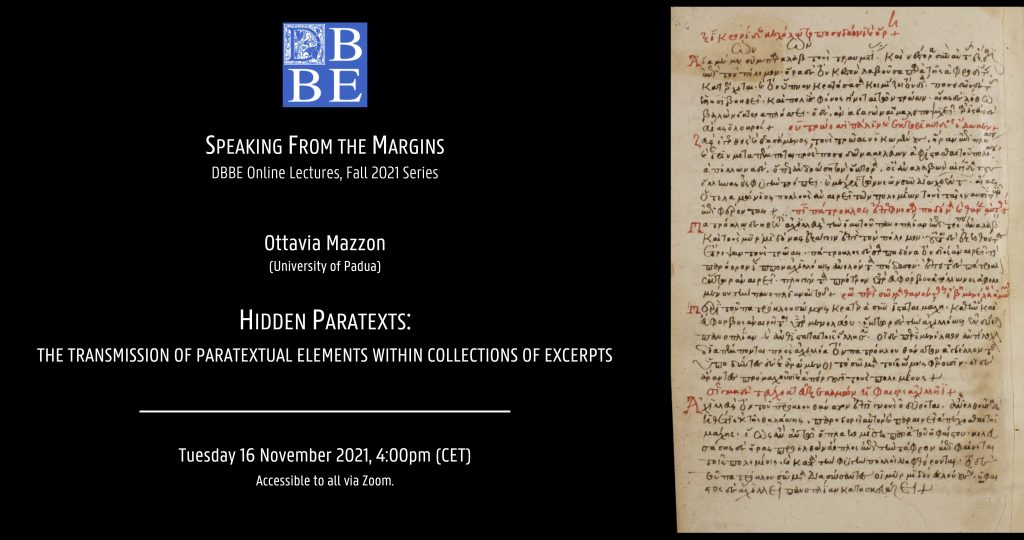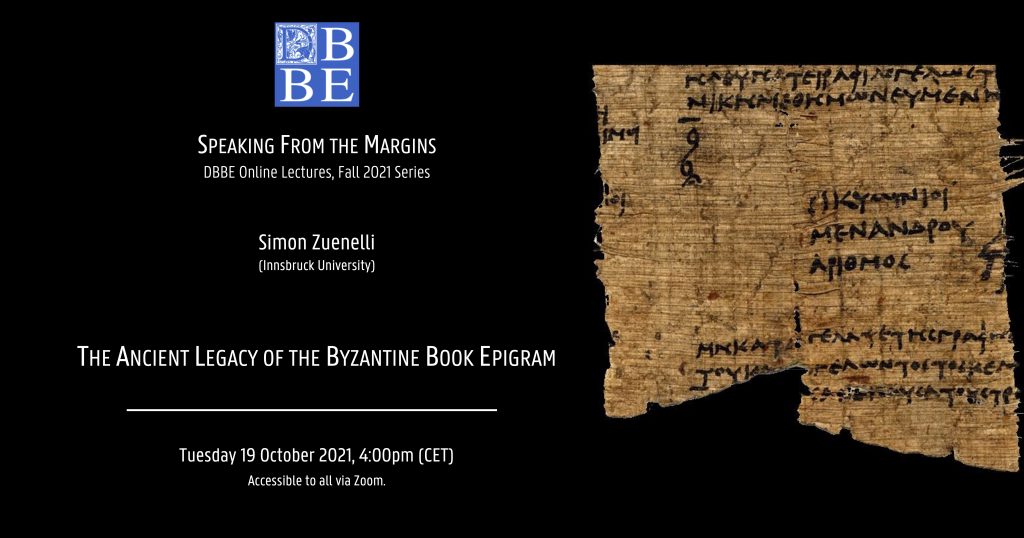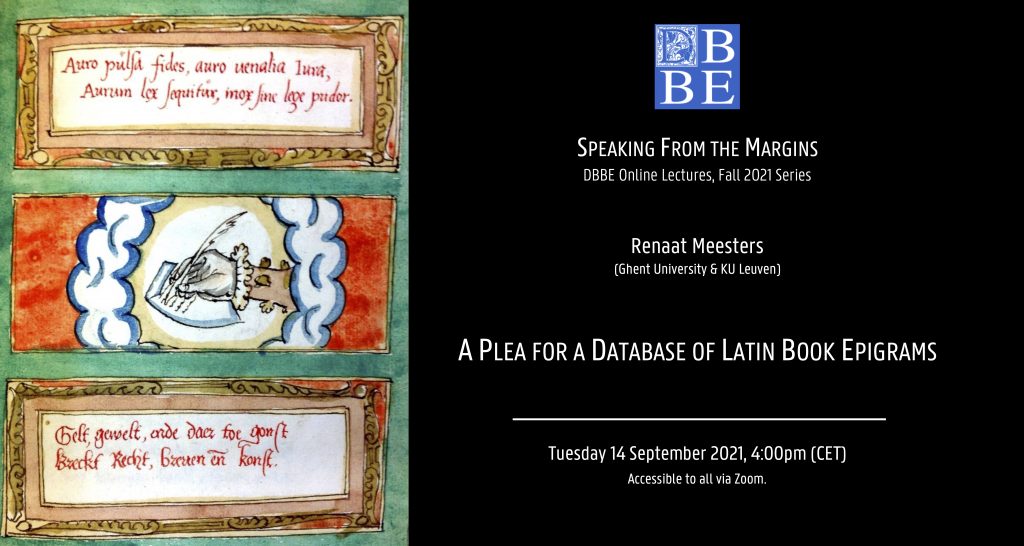The third lecture in the online lecture series Speaking From the Margins. DBBE Online Lectures, Fall 2021 Series will be given by Ottavia Mazzon (University of Padua).
Ottavia Mazzon is currently Frances A. Yates Long-term Fellow at the Warburg Institute and a post-doc researcher at the University of Padua. Her research interests lie at the intersection of classical philology and book history, focusing on the readership and material reception of ancient Greek literature in Byzantium and in Renaissance Europe. Her first monograph, Leggere, selezionare e raccogliere excerpta nella prima età paleologa. La silloge conservata nel codice greco Neap. II C 32, is forthcoming with Edizioni dell’Orso (Hellenica, 99).
Abstract
Byzantine intellectuals frequently put together collections of excerpts aiming to preserve the most interesting passages they encountered while reading. Many of these have survived, especially from the Palaeologan period, allowing us to explore Byzantine scholars’ reading interests and to understand how they used their books. Whenever they read, Byzantine scholars did not exclusively focus on literary works they were studying. When consulting a codex, they also took notice of the paratexts and sometimes ended up transcribing them alongside the quotations they had selected from the main text; the paratexts thus became an integral part of excerpt collections.
The objective of my paper is to show how the DBBE is an effective tool for the identification of paratextual elements within an excerpt-collection and facilitates the reconstruction of the material characteristics of the manuscripts read by the excerptor(s), going so far as providing essential information for the recognition of the exemplar employed. I will do so by presenting examples from two excerpt collections from the early Palaeologan period which I have chosen as a case-study: the Rhodoniai of Makarios Chrysokephalos, preserved in MS Marc. gr. Z. 452 (coll. 796), and the excerpt-collection transmitted by MS Napoli, Biblioteca Nazionale, II C 32. The book epigrams preserved in the latter are partially known; Neap. II C 32 contains a poem summarizing the content of the Iliad, which accompanies the hypotheseis to each book (ff. 366r-371v).
Practical information
Date & time: Tuesday 16 November 2021, 4:00pm (CET)
No registration required. The lecture is freely accessible via Zoom: https://ugent-be.zoom.us/j/96553291684?pwd=SyticTAxYmpLVy9sYm5RNzFHYUJjQT09.
- Meeting ID: 965 5329 1684
- Passcode: 8u5s8CW3
N.B.: A Zoom account is required to join this meeting. Please make sure to be logged in, using your Zoom credentials.

The second lecture in the online lecture series Speaking From the Margins. DBBE Online Lectures, Fall 2021 Series will be given by Simon Zuenelli (Universität Innsbruck).
Dr Simon Zuenelli is Assistant Professor at Innsbruck University (Austria) and chief editor of the review journal Anzeiger für die Altertumswissenschaft. His research focuses on post-classical Greek poetry. He authored several contributions on Nonnus’ Dionysiaca and is currently preparing a monograph on the ancient Greek book epigram.
Abstract
As the DBBE effectively shows, the production of book epigrams was indeed a popular phenomenon in the Byzantine Middle Ages. Yet, the book epigram is not a Byzantine invention, but rooted in a long tradition going as far back as the Hellenistic period. The history of the ancient book epigram is currently being investigated in the project “The Ancient Greek Book Epigram”, funded by the Austrian Science Fund and carried out at Innsbruck University. In my paper, I would like to present some of the results gained so far, which can lead to a better understanding of the evolution of the Byzantine book epigram tradition. Accordingly, my paper will highlight the continuity of book epigram production between Antiquity and the Middle Ages.
More specifically, after a brief general introduction to the ancient Greek book epigram, the paper will firstly deal with the continuity on a generic level. To this end, the type of the ancient “scribe-related epigram”, where the aspect of continuity is particularly visible, will be discussed. Secondly, two important issues related to the practice of Byzantine book epigram production will be addressed, namely the question of visual presentation and that of textual fluidity (or textual recycling). Taking P.Lond.Lit 11 as an example, several striking parallels with the ancient book epigram tradition in regards of both phenomena will be presented. This analysis will eventually lead to the general discussion of how to determine the “origin” of single Byzantine book epigrams.
Practical information
Date & time: Tuesday 19 October 2021, 4:00pm (CET)
No registration required. The lecture is freely accessible via Zoom: https://ugent-be.zoom.us/j/99768938150?pwd=RkVaRlBLeGRxSTFXUmFoU1FvUWVWZz09.
- Meeting ID: 997 6893 8150
- Passcode: Pk1QAR6S
N.B.: A Zoom account is required to join this meeting. Please make sure to be logged in, using your Zoom credentials.

The first lecture in the Fall 2021 Series of Speaking From the Margins. DBBE Online Lectures will be given by Renaat Meesters (Ghent University & KU Leuven).
Renaat Meesters was a heuristic collaborator (scribe) of the DBBE from 2011 to 2013 and obtained his doctoral degree in 2017 at Ghent University with a dissertation on Byzantine book epigrams on John Klimax. Since 2016 he is a teacher of Greek and Latin at the College of Essen and a voluntary postdoctoral researcher at Ghent University and KU Leuven.
Abstract
Since its inception in 2010, the DBBE has disclosed an important corpus of medieval Greek texts to the academic community, shedding new light on a plethora of aspects of Byzantine book culture. Regrettably, there is currently no similar project for the collection, cataloguing and edition of metrical paratexts written in Latin. Despite some examples of Latin epigrams which have received a certain measure of attention, this considerable corpus remains seriously understudied.
The purpose of this paper is to promote the idea of founding a Database of Latin Book Epigrams (DLBE), inspired by the DBBE. Therefore, a broad overview of the corpus will be sketched by presenting some Latin book epigrams, mostly selected from manuscripts preserved in the Royal Library of Belgium (KBR) in Brussels. These examples will be compared to Byzantine book epigrams that reveal similar generic features. The observation that Byzantine and Latin book epigrams have a lot in common, underlines the feasibility of setting up a database of Latin book epigrams, which may lead to a better and more thorough understanding of mediaeval book culture in general and of book epigrams in particular.
Practical information
Date & time: Tuesday 14 September 2021, 4:00pm (CET)
No registration required. The lecture is freely accessible via Zoom: https://ugent-be.zoom.us/j/94069376394?pwd=NzNtVzRjTlphNzgzS25GSUxsQ2tzUT09.
- Meeting ID: 940 6937 6394
- Passcode: iLtrHAu2



